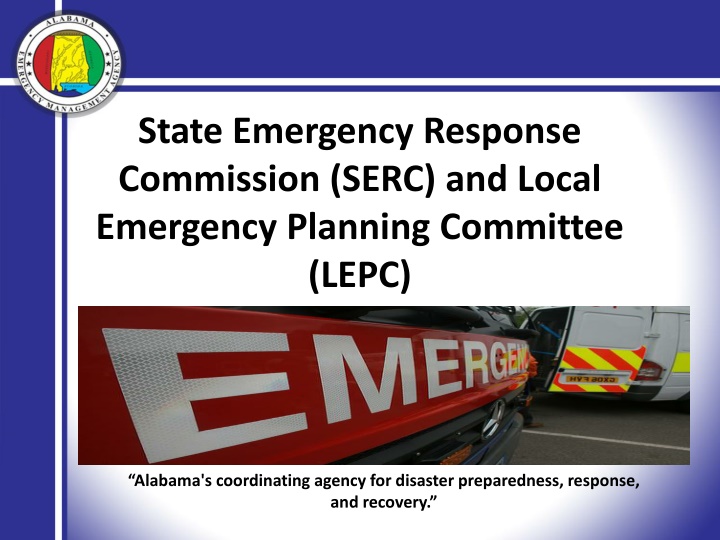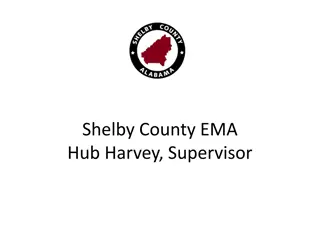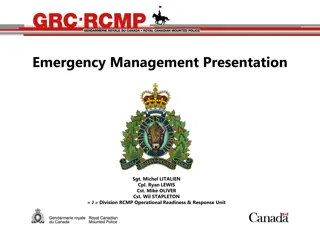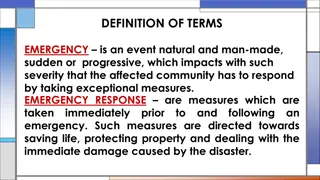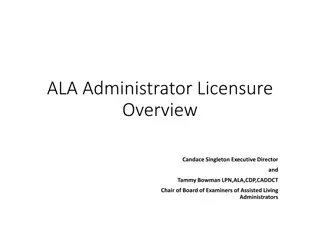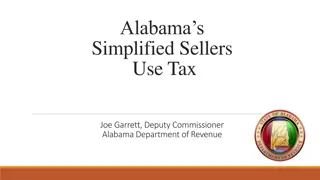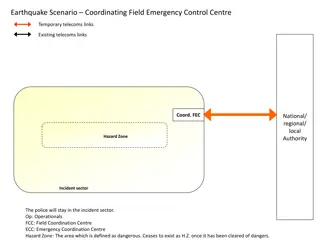Alabama State Emergency Response Commission (SERC) and Local Emergency Planning Committee (LEPC)
Alabama's State Emergency Response Commission (SERC) and Local Emergency Planning Committee (LEPC) are key agencies responsible for disaster preparedness, response, and recovery. The SERC, formed by Executive Order Number 4, appoints agencies like the Alabama Emergency Management Agency (AEMA) and Alabama Department of Environmental Management Agency (ADEM) to oversee emergency planning. The SERC's goals include assisting LEPCs with hazardous materials emergency plans, sharing chemical information, providing release reporting procedures, and administering the HMEP Grant. LEPCs serve as forums for industry, responders, and the public to evaluate and plan for chemical hazards in the community.
Uploaded on Sep 26, 2024 | 5 Views
Download Presentation

Please find below an Image/Link to download the presentation.
The content on the website is provided AS IS for your information and personal use only. It may not be sold, licensed, or shared on other websites without obtaining consent from the author.If you encounter any issues during the download, it is possible that the publisher has removed the file from their server.
You are allowed to download the files provided on this website for personal or commercial use, subject to the condition that they are used lawfully. All files are the property of their respective owners.
The content on the website is provided AS IS for your information and personal use only. It may not be sold, licensed, or shared on other websites without obtaining consent from the author.
E N D
Presentation Transcript
State Emergency Response Commission (SERC) and Local Emergency Planning Committee (LEPC) Alabama's coordinating agency for disaster preparedness, response, and recovery.
Creation of the Alabama SERC Alabama Executive Order Number 4: Alabama Executive Order Number 4: Appoints the Alabama Emergency Management Agency (AEMA) and the Alabama Department of Environmental Management Agency (ADEM) to carry out the provisions on the EPCRA Act and established the Alabama State Emergency Response Commission (SERC).
Executive Order 4 Responsibilities AEMA: Appoint local emergency planning districts to facilitate preparation and implementation of emergency plans and training for local planning and response organizations. ADEM: Maintain jurisdiction over chemical releases, serve as the repository of the lists of chemical inventory forms, and provide public access to the lists, forms, and information.
Executive Order 4 Responsibilities Hazardous Materials Advisory Group: All appointed provide information to their counterparts in membership and assistance as needed. Disseminate information to public and private sector.
SERC Goals Assist LEPCs with hazardous materials emergency response plans Share hazardous chemical information Provide release reporting procedures Administer the HMEP Grant
What is an LEPC A Local Emergency Planning Committee (LEPC) exists to be a forum for emergency management agencies, responders, industry and the public to work together to evaluate, understand, train about, coordinate and communicate chemical hazards in the community and develop hazardous materials emergency plans
LEPC RESPONSIBILITIES To provide a planned coordinated response to hazardous materials releases in a way that minimizes the impact on the community and it s citizens To develop and manage the emergency response plans dealing with accidental releases from facilities To distribute information to the general public
LEPC GOALS Determine the degree of hazardous materials located in and moving through the local emergency planning district Determine the trained response personnel and resources Evaluate the effectiveness of emergency response plans Determine at risk populations and safety measures needed
LEPC MEMBERS Law Enforcement Fire Transportation Media Utilities Industry EMA Government Medical Media General Public
REPC CONCEPT At present, each county in Alabama is a local emergency planning district A regional concept proposes an REPC (Regional Emergency Planning Committee) in each EMA division in the state Each division would be a local emergency planning district A REPC is composed of several counties who have formed a working relationship in order to accomplish an operational response to hazardous materials incidents at fixed facilities
REPC BENEFITS Line up with the already established EMA divisions throughout the state Would encourage cooperation among counties and enhance the planning process Would reduce operational costs and would aid in grant application and funding Would enhance the response efforts and identify resources Would enhance training efforts
MAJOR HAZARDOUS MATERIALS FACILITIES DIVISION A State Port, Southeast Shipyards, Dupont, McPherson Company DIVISIONB Wayne Farms, Farley Nuclear Plant DIVISION C Nucor, Hunt Refining, Peco Foods DIVISION D Hyundai Plant, Rheem Manufacturing DIVISION E Hillshire Brands, Mar-Jac Poultry DIVISION F Cinram Group, BASF Corporation, Browns Ferry Nuclear Plant DIVISION G American Cast Iron Pipe, Vulcan Threaded Products, RMC
CONTACTS Robert Thomas Operations Section Chief robert.thomas@ema.alabama.gov earl.alexander@ema.alabama.gov 205-280-2233 205-280-2253 Earl Alexander Infrastructure Branch Director Marieke Fendley Planning Section Chief marieke.fendley@ema.alabama.gov Robert.baylis@ema.alabama.gov 205-280-2243 205-280-2453 Robert Baylis EM Planner
